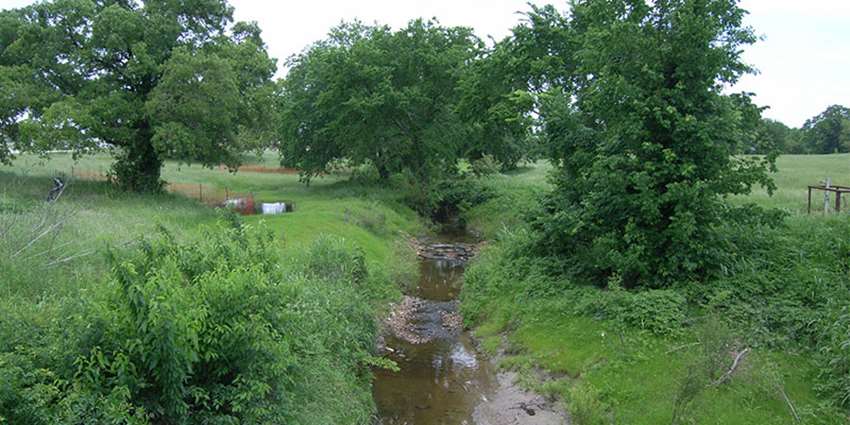On the sprawling Texas A&M University campus, a tributary of White Creek begins near the Horticulture/Forest Science Building and flows into White Creek just before the George Bush Presidential Library and Museum. The land around this tributary is part of the recently established Gardens at Texas A&M and is home to native plants and wildlife, including over 50 bird species.
Expanding campus construction poses environmental and ecological threats to the White Creek ecosystem, according to experts. In response, a White Creek Tributary Restoration project was developed to help protect and restore this riparian area from increased stormwater flows, construction and pedestrian traffic that was leading to degradation of the creek. TWRI’s Nikki Dictson, extension program specialist, and Clare Entwistle, research associate, recorded water quality and monitored the recovery of vegetation around White Creek before and after the restoration project.
“With all the new buildings being constructed, including dorms and university buildings, impervious surfaces from the new rooftops and parking lots have increased,” Dictson said. “Impervious surfaces speed up stormwater flow that erodes the land and stream banks, resulting in the creek cutting down and beginning to widen to deal with these increased flows. The university wanted to make sure it wasn’t going to degrade the creek even more with additional impervious surfaces on both sides of the creek and a new stormwater channel entering at the creek bend.”
For years, a technical committee of university officials, specialists and scientists discussed the best way to restore and protect the creek, as well as how the stream restoration project could be used for educational demonstrations, Dictson said.
The aim of the stream restoration project is to improve the health of the ecosystem by stabilizing the creek bed and banks, reshaping the creek channel at key locations and restoring it to its native plant biodiversity, as well as to increase its aesthetic beauty, she said. The area will also be used for educational demonstrations on riparian and creek restoration and other water management strategies.
The project began in January 2015 and was split into three phases, beginning with dirt and rock work to reshape and stabilize the creek, then a revegetation and planting phase, and lastly construction of a downstream bridge. Funds from Texas A&M Residence Life, the College of Agriculture and Life Sciences and Transportation Services provided the financial support to help stabilize the banks and create a pedestrian path and the bridge.
The construction team put rock structures in the creek bed to change the elevation and stabilize the creek and banks as well as create the natural riffle, run, and pools, Dictson said. In key areas where they resloped the banks, the team installed stabilizing vegetation such as willow trees, used erosion control blankets and seeded for native vegetation, as bank erosion control measures. All of the stormwater inlets were also stabilized with rocks and vegetation. A portion of the creek bank was reshaped and stabilized around a sharp curve, which will slow down the flow of water and prevent bank damage and flooding, Dictson said.
Dictson and Entwistle tested for water quality by monitoring temperature, conductivity, pH, flow and dissolved oxygen periodically before construction began, as well as taking weekly photos before and during construction.
“We wanted to see how the land and vegetation changed over time,” Dictson said. “The change is amazing in how quickly the impacted vegetation and stream recovered.”
Due to the high concentration of sediment loads in the creek during the bed restoration and bank stabilization phase, they did not test for water quality once construction began, Dictson said. They will return later to test water quality.
“We have continued to take more photos to monitor the changes and growth in vegetation and if any erosion occurs,” she said. “This project has withstood several large rainfall/runoff events. We are also using the pictures of this restoration work in our Riparian and Stream Ecosystem Education programsacross the state to show how restoration projects progress and improve the quality and health of the stream and ecosystem.”
Visit White Creek Restoration and The Gardens for more information. For a bird’s-eye view of the tributary, use this interactive Texas A&M campus map.

